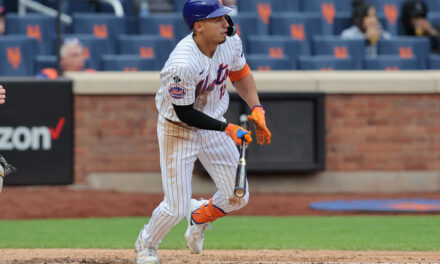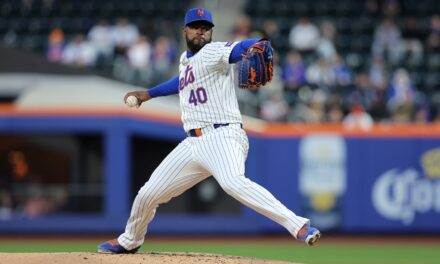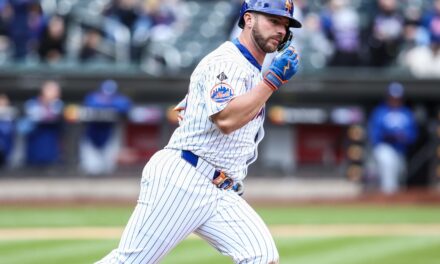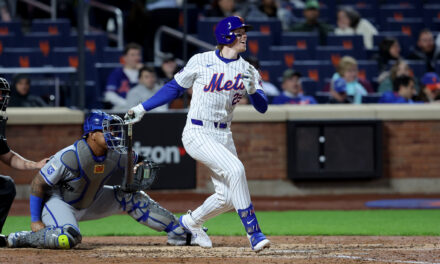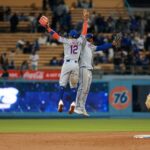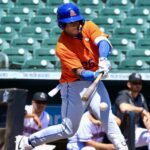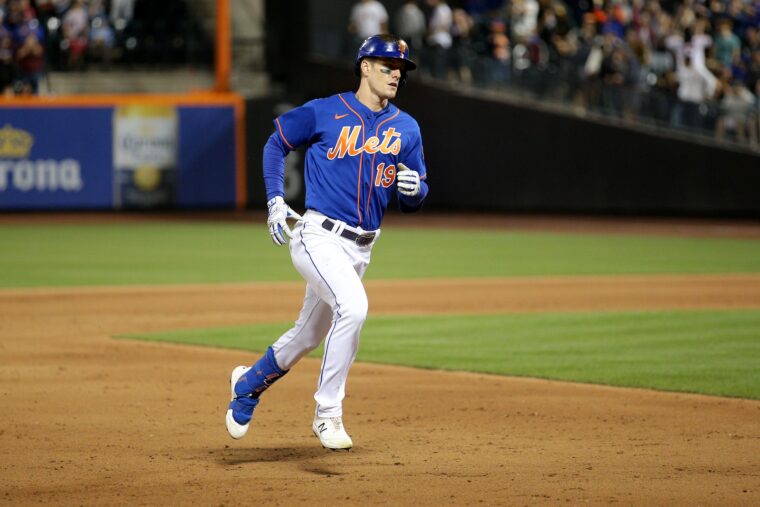
Mark Canha. Brad Penner-USA TODAY Sports
When the Mets signed Mark Canha to a two-year deal in November 2021, his role on the team did not seem to be clear-cut. After all, they inked Starling Marte shortly thereafter and had Robinson Cano penciled in at second base, which left Jeff McNeil without an everyday spot. The assumption was that McNeil would take at least some of the at-bats in left in addition to second and possibly third base.
Once the Mets released Cano, left became Canha’s permanent job. The 33-year-old played in 140 games and recorded 542 plate appearances. His numbers were pretty solid, too: most teams would take a slash line of .266/.367/.403 for an OPS of .770 (122 OPS+) from their number seven hitter. Canha’s wRC+ of 128 was rock-solid and contributed to a Mets’ offense that ranked fifth in the major leagues in runs scored.
Given that introduction, it would seem obvious that Canha earned a starting job in 2023. Indeed, the Mets appear ready to roll with Canha as their left fielder, with reports that they are seeking a backup outfielder rather than one with a larger projected role.
However, there is reason to believe that Canha should be more of a platoon player than a starter. What makes the right-handed outfielder a less-than-ideal everyday player, and what are the Mets’ options for a possible platoon?
Brandon Nimmo Sr.
Canha profiles very similarly to Brandon Nimmo offensively—only Nimmo is considered far superior. Consider these numbers:
- Canha: .266/.367/.403/.770, 122 OPS+, 128 wRC+, .343 wOBA, 8.9% BB%, 17.9% K%
- Nimmo: .274/.367/.433/.800, 130 OPS+, 134 wRC+, .353 wOBA, 10.5% BB%, 17.2% K%
The question is why that’s a problem. Wouldn’t you want more Nimmo-like hitters in your lineup? However, take a look at another Mets’ hitter, Jeff McNeil:
- McNeil: .326/.382/.454/.836, 140 OPS+, 143 wRC+, .365 wOBA, 6.8% BB%, 10.4% K%
While McNeil does not profile as the exact same type of hitter — he makes more contact while both walking and striking out significantly less—there are certain similarities. His wRC+, OPS+, OBP, and wOBA are all in the same ballpark, but he does it better than both Nimmo and Canha.
None of these guys hit for a lot of extra bases, though, and that’s what contributed to the difficulty the Mets had scoring runs at times despite 10+ hits in a game.
Isolated Power (ISO) is a statistic that measures extra base rate. League average is roughly .140, while .170 is above average, .200 is great, and .250 is excellent. (For reference, Aaron Judge led baseball with a .375 ISO in 2022.)
McNeil’s ISO was .128 in 2022, while Canha’s was .136 and Nimmo’s was .159. McNeil’s ISO can be tolerated just because he gets on base at such a high clip; Nimmo’s is still close to above average. Canha, however, showed a roughly league-average ability to hit for extra bases while not bringing surplus value in other areas. It’s not that Canha is bad; it’s more that the Mets could use a mix of skills rather than so many similar ones, particularly when that does not include power.
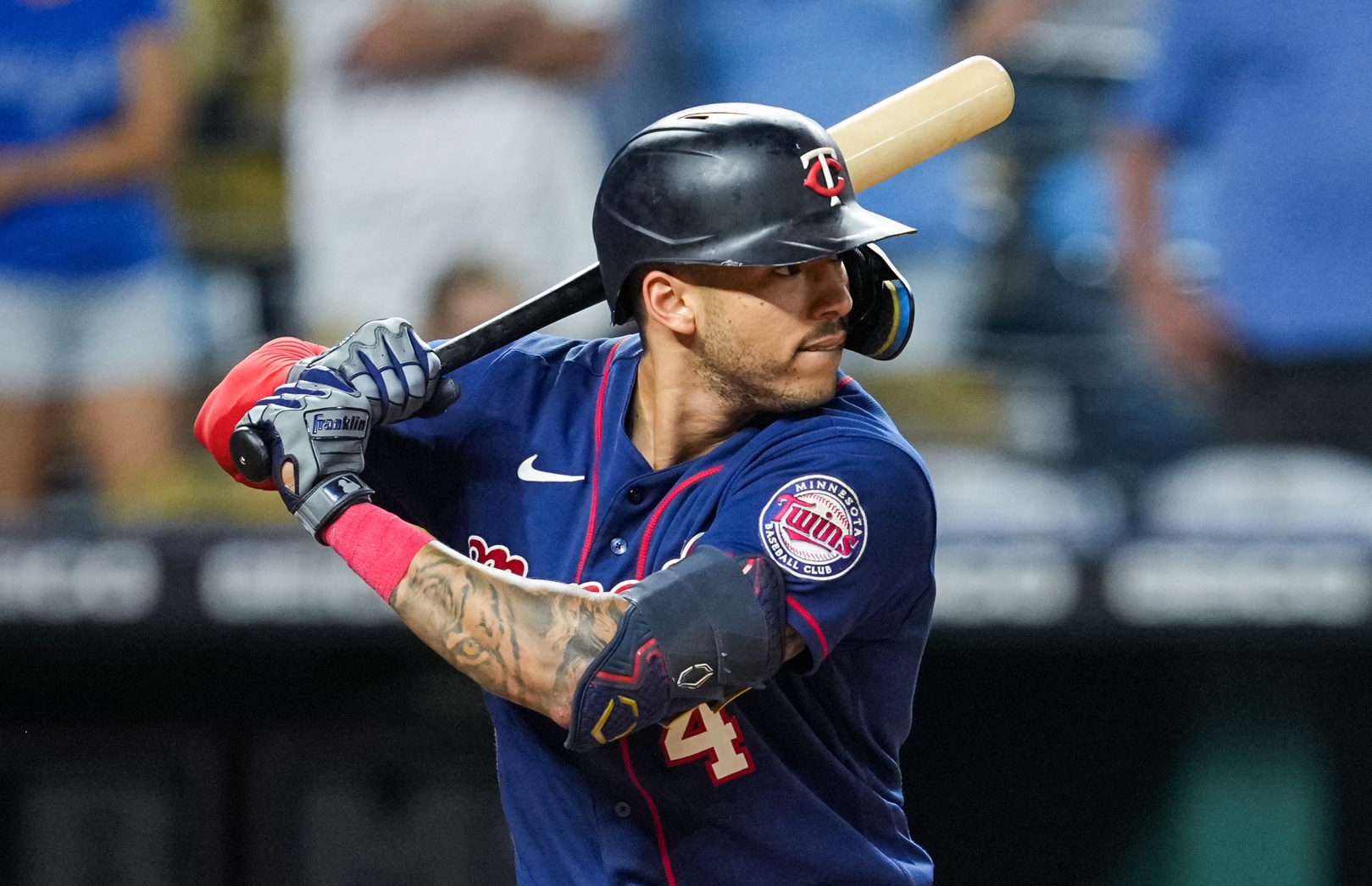
Carlos Correa. Jay Biggerstaff-USA TODAY Sports
Now, if the Mets do end up signing Carlos Correa, it’s more likely that their lineup will be just fine with Canha batting seventh or eighth and putting up roughly career-average stats, even if some of those are slightly lower than what he produced in 2022. Canha’s career .242/.345/.391 (.736 OPS) slash line, .338 wOBA, and 118 wRC+ are perfectly adequate.
If the Correa deal falls through, though, the Mets will be lacking that thumper. They do not appear inclined to start Francisco Álvarez from day one, and even if they did, Álvarez will likely deal with the major league learning curve. Ditto for Brett Baty, although he is more likely to make the Opening Day roster if Correa is not a Met. Once again, the Mets will be left with 1.5 power hitters in Pete Alonso and Francisco Lindor (whose ideal role is not as a power-focused hitter, but rather as a player who can take the ball where it comes).
The Mets need some more power in their lineup, and left field is one of the top positions to upgrade in that area.
Defense
Canha graded out as a net liability as a left fielder in 2022. Defensively, he put up -1 OAA, -5 DRS, and -4.0 UZR in left. His arm strength of 82.3 was in the 31st percentile, well below the league average of 87.4 for left fielders. He also ranked in the 31st percentile in his average jump on balls hit his way. This accounted for part of the discrepancy between his fWAR and those of Nimmo and McNeil. While Canha’s fWAR was only 2.8, Nimmo put up 5.4 and McNeil 5.9.
The Mets’ top two pitchers, Max Scherzer and Justin Verlander, profile as flyball pitchers. They put up groundball/flyball ratios of 0.46 and 0.62 in 2022, respectively. If the Mets want to get the most out of their pitchers, they’ll need good outfield defense. It would behoove them to put someone more capable out there.
Hitting Lefties
The Mets as a team were middle-of-the-pack against lefties in 2022, at least in terms of most of the traditional statistics. They slashed .246/.322/.394 (.716 OPS) against southpaws, all ranked between 13th and 15th in the major leagues. However, that’s a far cry from their performance against right-handed pitchers, which yielded a .265/.336/.420 (.756 OPS) line, all ranked between second and sixth.
Canha struggled comparatively against lefties in 2022, slashing .241/.335/.398 (.733 OPS) against them compared to .280/.385/.405 (.790 OPS) against righties. The Mets could use a platoon hitter who hits lefties more effectively, particularly in the slugging department.
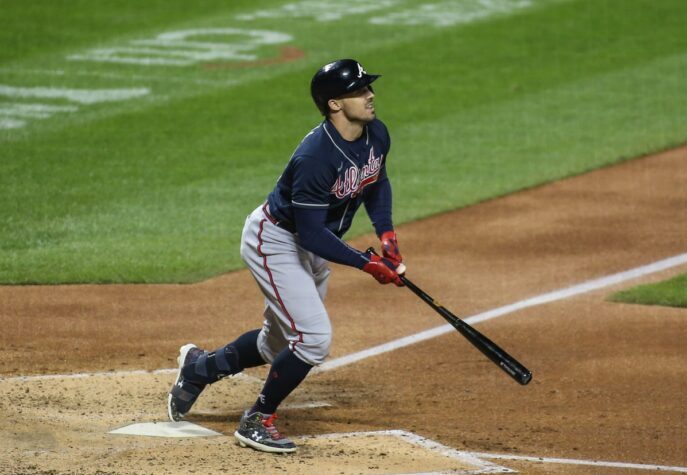
Adam Duvall. Credit: Wendell Cruz-USA TODAY Sports
What Are the Options?
Realistically, is there anyone on the Mets’ roster or available via free agency who can complement Canha’s strengths and weaknesses? There are a few options.
Adam Duvall
Adam Duvall would have been an interesting name just one off-season ago, but he’s coming off the worst season of his career. In 287 at-bats last year, Duvall hit .213/.276/.401 (.677 OPS) with an 87 OPS+ and 0.9 fWAR (-0.1 bWAR). Duvall did still hit 12 home runs at a clip of one homer per 23 at-bats, but that was a far cry from 2021, in which he had one homer per 13.5 at-bats. He continued to strike out nearly one-third of the time (32.1% K%) and put up an 87 wRC+.
Duvall did hit lefties significantly better than righties in 2022, slashing .233/.282/.562 (.844 OPS) against them in 78 plate appearances compared to .206/.274/.346 (.620 OPS) against righties. However, for his career, Duvall’s splits from both sides of the plate are pretty similar, with an identical batting average (.230) and nearly identical slugging percentage (.465 vs. .468). His OPS is somewhat higher against lefties (.771 vs. .749).
Defensively, Duvall has always profiled well. He won a Gold Glove in 2021 and recorded another 5 OAA in 2022. However, he did record -1.9 UZR in left field, compared to 3.8 in 2021. He had similar declines at the other two outfield positions. He recorded an 87.8 Statcast Arm Strength rating and 89.1 overall, both above average and significantly better than Canha’s.
The question would be whether the Mets believe that Duvall’s 2022 season was an outlier or a sign of decline in a 34-year-old outfielder. Baseball Reference has decent 2023 projections for Duvall, expecting a .225/.284/.439 (.723 OPS) line with 21 homers in 413 plate appearances. Fangraphs is less sanguine, predicting a .209/.269/.401 (.670 OPS) split with 16 homers in 343 plate appearances.
Ultimately, I don’t know if the Mets would sign up for that kind of production compared to Canha’s unless they believe that Duvall should start to give some more pop against lefties.
Jurickson Profar
Jurickson Profar has been linked with the Mets as a possible option in the outfield. Profar hit .243/.331/.391 (.722 OPS) in 2022 with a 111 OPS+, 110 wRC+, and 2.5 WAR. His 11.1% walk rate vs. 15.7% strikeout rate is intriguing. He hit 15 homers in 658 plate appearances, though, which is a lower ratio than Canha had.
Profar did bat slightly better against lefties than righties, putting up a .259/.352/.382 (.734 OPS) line against southpaws. However, his slugging percentage was lower than Canha’s against lefties, and his OPS was the same. He does not seem to bring any particular batting advantage over Canha, especially in the areas that the Mets could use it the most.
Profar recorded 1.1 UZR in left field in 2022, but he also put up -5 OAA. The Mets could potentially be intrigued by the fact that Profar has shown significant versatility over the course of his career, playing all over the infield and outfield, including second base as recently as 2021. However, his defensive results have mostly been on the below average side of the coin. He does have a significantly stronger arm than Canha, recording an 87.0 Arm Strength by Statcast metrics.
Overall, Profar would slide in okay as a backup outfielder, but he would not be a legitimate platoon option with Canha.
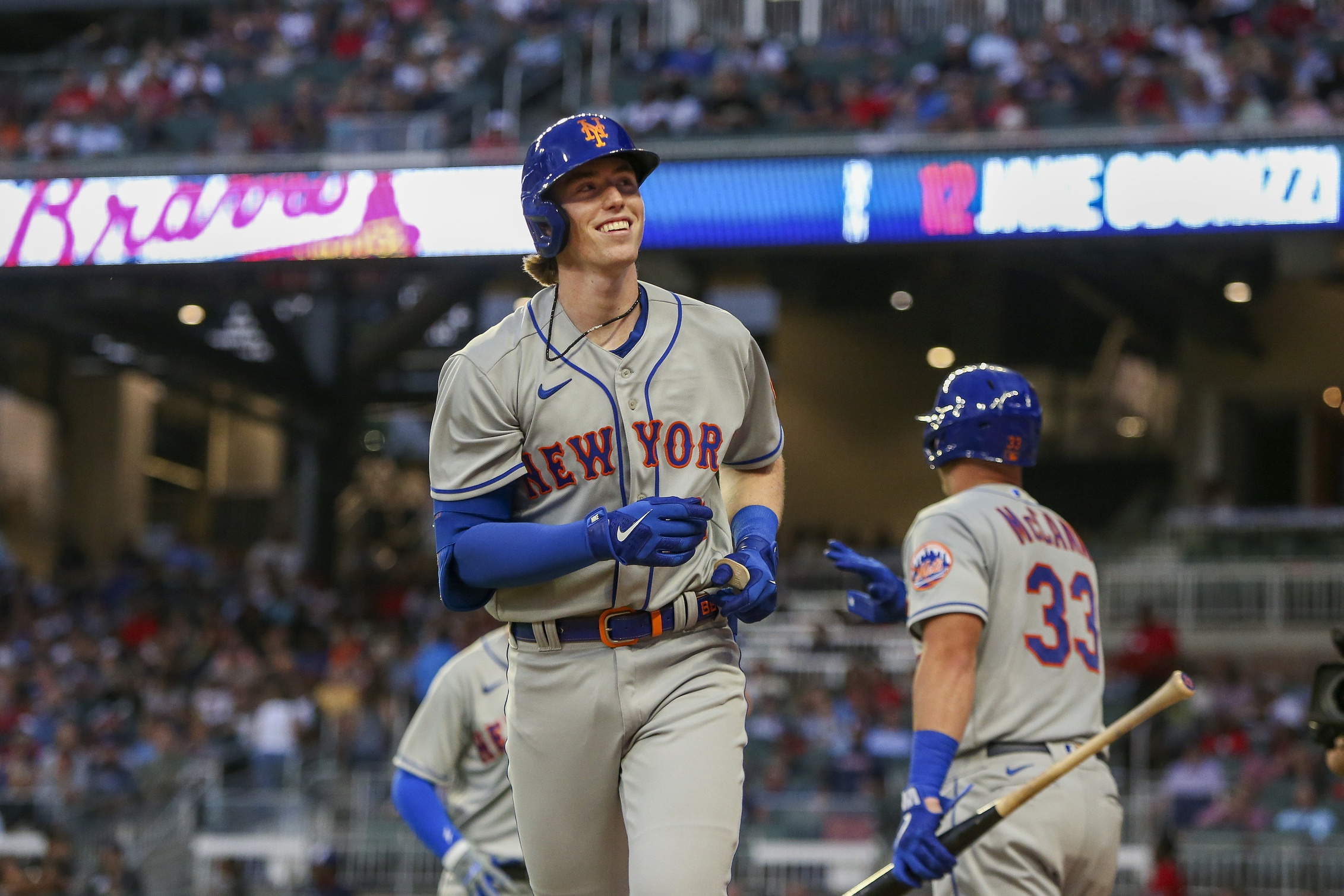
Brett Baty. Brett Davis-USA TODAY Sports
Brett Baty
Brett Baty is still considered one of the Mets’ untouchable prospects, and depending on what happens with Carlos Correa, he could find himself in the Minors to start 2023. If Correa does sign, it’s likely that the Mets would try to fully convert Baty to a left fielder at Triple-A. Baty did play 29 games in left in the outfield, and the Mets were intrigued by the possibility due to Baty’s struggles at third base and his reportedly strong arm.
One of the questions about Baty is whether the Mets would want to bring him to the major leagues unless he was playing everyday. They would prefer that he get regular playing time to build his skills rather than languish on the bench. One way to give him significant playing time would be to platoon him in left field with Canha and use him as a DH/bench player the rest of the time. They would need to feel confident that Baty can hold his own in left, though.
Baty’s 7-for-38 stat line in his 11 games played last season is hardly impressive, but his batted ball profile hinted of the potential that the Mets see in his bat. His average exit velocity of 91.1 MPH was above the MLB average of 88.4, and his xBA of .287 suggested that a breakthrough might be around the corner as Baty started to elevate the ball more (which happened as he advanced through each level of the minors). Baty also showed a nice opposite field swing, going that way 30% of the time compared to a 33.3% pull rate.
Baty’s potential as a power hitter makes him an intriguing candidate for the Mets’ roster. With Correa’s status in doubt, there is the possibility that he makes the Opening Day roster as a backup or platoon third baseman. However, if Correa does sign, it is still likely that Baty finds his way to the Majors at some point in the season, and left field is as likely a spot as any.
Baty is a left-handed batter and had only nine plate appearances against lefties last season, recording one hit. The Mets believe that he can eventually learn to hit lefties as well as righties. In 2022, Baty’s total slash line against lefties (minors included) was .241/.305/.437 (.742 OPS) with five doubles and four homers in 87 plate apperances, which means that he can bring some pop against southpaws, as well.
What Will Happen?
Most likely, regardless of what happens with Carlos Correa, Mark Canha will be the Mets’ starting left fielder in 2023. As stated earlier, a team can do far worse with their number seven hitter. However, if the Mets want some thump from that position, they might consider bringing in Adam Duvall to push Canha for some at-bats or allowing Brett Baty some time in left. This is particularly true because Canha is a free agent after 2023, and giving Baty more time in left would allow them to evaluate whether he can be their left fielder of the future.
Overall, the Mets will all but certainly bring in a backup outfielder this off-season. With the injury histories of both Brandon Nimmo and Starling Marte, it’s more likely than not that they will need to prioritize backups at the other outfield positions as opposed to left field. They also have Jeff McNeil as a more-than-capable option in left, giving them some stability there.
Still, it is important to think ahead. Mark Canha is a good player, but his skillset similarities with other Mets’ players makes Brett Baty an intriguing long-term foil on the team.
Note: batting stat lines per Baseball Reference; defensive stat lines per Fangraphs Baseball; Arm Strength metrics per Statcast.


